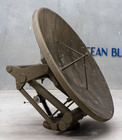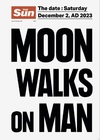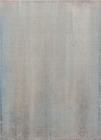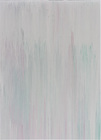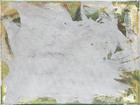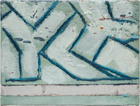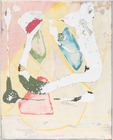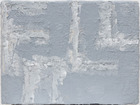Moon Walks on Man
Matthew Taft interview with Oscar Perry
Matthew Taft: In your last show at The Commercial, ‘Spoorloos,’ it seemed to me that your paintings were striving to give aesthetic form to the invisible infrastructure that controls our everyday lives. In inverting the relationship between individual agency and external environment, the title of this show, ‘Moon Walks on Man,’ suggests a continuation of this preoccupation. Do you see this relation as animating this work?
Oscar Perry: Yes, I think this show expands the territory I was trying to explore in the ‘Spoorloos’ show. If that exhibition was a process of ghost mapping or conjuring. I think these works are more like frequencies or signals. Messages that get received. Waves of information to be deciphered. ‘Moon Walks on Man’ presents a closing in, a turning inward … the messenger returning.
MT: Could you tell me about some of the raw materials—disembodied textual fragments and a decontextualized satellite dish—that appear in this exhibition? What histories do they fossilize and what about them appealed to you?
OP: The show is made up of lettered signs on the walls and a large military style satellite dish in the centre of the gallery. The text works came from a variety of sources–interviews, lyrics, translations, films etc. I’d seen a clip of the guitarist Joe Walsh from the Eagles being interviewed about the potential negative impact of AI on music. And he basically concludes that AI can’t destroy a hotel room, and that until it can he doesn’t take it seriously. I think there is something in that interview about style. He’s asked about music and he talks about destruction. It’s like some doomsday proverb …
The satellite dish was conceived as a rooftop receiver. A defunct conductor for language and memory. My idea was to use the gallery as a vantage point. I grew up around a lot of people that had dishes in their backyards. Families watching Greek and Italian news, football and soaps etc. They feel like ancient sundials.
MT: Yeh, for these migrant communities in Melbourne’s north, where both you and I grew up, these satellite dishes were a way for folks to keep their feet planted in the soil of the old country. That even in suburban Australia, one could receive messages from afar that situated families within a globalised world. Rather than keeping us grounded, the satellite dish in this show, as you say, is defunct and ancient. It is more like wandering a lunar landscape receiving messages that we are no longer capable of deciphering. Do you see this work as lamenting this loss or expressing the emergence of new possibilities?
OP: I’m not sure. I think the work moves between both of these zones. Looking forward as a way to understand the things we have lost or vice versa. A lot of science fiction deals with this notion. Arthur C. Clarke, the English science fiction writer, proposed the idea of satellite communication in 1945. As objects, satellite dishes are imbued with a certain feeling, something close to longing. Like these suburban metal sun flowers or space poppies.
There is something about this cultural dislocation and these dishes as outposts. They always looked pretty natural amongst the concrete veggie boxes and homemade greenhouses. Maybe this type of Greek and Italian suburbia I grew up around was a sort of utopian science fiction. I was always confused by succulents. I think landing in 1940s Australia would probably be stranger to us now than slotting into Blade Runner.
MT: There is also a cultural dislocation in the text works, language dislodged from its milieu (page, song, film, and so on). How do you see the relationship between the sculptural and the textual in this show? And between the text works and the satellite dish?
OP: The text works generally come from notes, snippets or fragments of conversations, film dialogue, songs etc. They are then transcribed into sculptured letters and fixed to the wall. I had the loose idea about language moving through space. The satellite dish becomes a destination or a conductor. The text is pulled towards them. I recently re-watched Two Lane Blacktop. The 1971 Monte Hellman road movie starring James Taylor and his mechanic Dennis Wilson (from the Beach Boys) racing various strangers and dragsters across America. The film is really about the car, the physicality of it. How it encapsulates this American void. In the car the men rarely speak. So the radio becomes the voice.
MT: You work with language in your poetry practice. What was the genesis or impetus for bringing text from the page to the gallery wall? How do you see the relation between your poetry and this exhibition?
OP: Initially, the poetry came out of writing titles for artworks–mostly rubbish titles. I then started making poetry books separately and performing and recording them with a band.
I try to keep them separate but there’s plenty of crossover. What I’d say about the text work in this show is none of them are mine, they are found fragments. I came up with the exhibition title but in terms of writing it’s really more of a readymade show. Affected Readymades.
MT: Your work often alludes to what could be loosely periodized as the counterculture of the 1960s and 70s (here, the references to Silent Running (1972), Point Blank (1967), Dennis Wilson’s album Pacific Blue Ocean (1977)). Are there cultural, artistic, or political currents from this period that you find alluring or, conversely, ominous?
OP: I think it has something to do with atmosphere and this sense of an ending. These hopeful years derailed. Conspiracy setting in. Experimentation and resistance replaced by paranoia and isolationism. The introduction to John Boorman’s film Point Blank is a good example. Lee Marvin walks through all these 60s buildings. Everything is immaculate. Perfectly designed. But he looks frantic. The sound of his footsteps ring out. The sound contradicts what you are seeing.

















